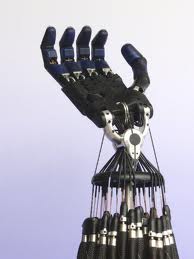Android Hands
Android Hands - Bionic Hands

There was a time when android hands, or rather robot hands were restricted to rugged two and three-finger grippers, capable only of the simplest of movements. The first ever working robot hand, in fact, was a two-fingered, heavily jointed, industrial claw that could only pinch and hold, and because it had no concept of sensitivity whatsoever, this basically meant that the robot hand clawed and grabbed indiscriminately at things.
Developed in 1960 by General Electric's Ralph Mosher, this android hand was called the Handyman. It was certainly a breakthrough during that time, though its design seems extremely rudimentary now. Its five-pivot segment design in each finger was considered innovative in attempting to replicate the human hand's flexible joint structure, and set up important foundations for the development of later hands.
A human hand is made up of a set of rigid links composed of bones and muscles connected at joints. Each joint can have one degree of freedom that could either hinge or slide, or two, which could either be rotating or cylindrical. Humans have four degrees of freedom in each finger, which give us massive flexibility and the ability to make highly sensitive and complex motions.
For any roboticist, researcher or developer, replicating the unique abilities of the human hand in an android hand has never been an easy task. With its complex muscular and skeletal structure, anybody who tries to recreate its form and function are usually faced with quite a challenging dilemma: the hand must dexterous, stable and strong, but at the same time be fast moving, flexible and precise.
Today, makers the android hand are using a host of innovations from a variety of disciplines that have brought us closer to fully functioning and fully automated hands. Technological advances within this field are continuously growing, and robotic hands with separately controllable fingers and joints based on human functions continue to come out of labs all over the world, each one seemingly more sophisticated than the next.
These android hands usually find their way to the industrial sector, performing more and more advanced work in the place of humans (like NASA’s Robonaut) but many have also found highly sophisticated functions in the medical world. Intuitive Surgical's Da Vinci Surgical System, for example, employs a robot hand with up to seven degrees of freedom and 90 degrees of articulation, making it the most precise robotic appendage in the medical world. The hand, or Endowrist, is widely used by surgeons because it allows them to perform minimally invasive surgery through tiny incisions, and in many ways are considered to be even more dexterous than a human surgeon’s own hand.
In medical prosthesis, these bionic/ robot hands are very much valued, as well. Dean Kamen’s Deka Research and Development Corp., a medical products company, for instance, received an $18.1 million grant from DARPA to create an advanced prosthesis that could be strapped on and used immediately. Kamen and his team created the Luke Arm prosthetic, whose motor control is imparted by the enormous amount of circuitry inside the arm, which allows up to 18 degrees of freedom. Interestingly, the Luke arm is controlled by controllers in the shoes of the user. Pushing down with the left big toe makes the arm move out; pressing down on the right big toe pushes the arm back in. Expert users can allegedly pick up paper cups and even peel bananas using this arm.
Another medical device developer, Touch Bionics, made the i-LIMB Hand, a prosthesis (robot hand) with five individually powered fingers and a partial hand prostheses called ProDigits, which utilizes traditional myoelectric signals. Myoelectric signals are electrical impulses generated by muscles in the remaining portion of a patient’s limb, which are then picked up by electrodes that sit on the surface of the skin. These signals are amplified and used to control artificial limbs. The company also developed a custom cosmesis, or covering, for its prostheses called the i-LIMB Skin: a thin layer of semi-transparent material computer-modeled to accurately wrap to every contour of the hand. The result: a more life-like appearance for the bionic hand.
The Southampton Remedi-Hand was designed by Dr. Paul Chappell, a medical physicist from the University of Southampton in the UK. This myoelectrically-driven prosthesis has independently-driven fingers and 6 degrees of freedom. It’s also made of a lightweight epoxy carbon fiber, which make its total assembly weight less than 500g - even lighter than a real hand. Dr. Chappell says that his aim is to create a hand with the functionality a human’s as well as a sense of touch. He is working on a technology that will “let the hand know just how tightly to grip an object like a coffee cup without dropping it, but not so tightly that it's crushed. It'll also have an integrated slip-sensor which will tell the hand if something is beginning to slip out of its grip so it can grip slightly harder. It'll be quite a clever system.”
Certainly, these are all amazingly clever robot hand systems, and truly massive leaps borne from the somewhat crude origins of the Handyman. But so far, no prostheses had been successful in completely replicating the flexibility of the human hand. This distinction goes to what is allegedly the most advanced commercial robot hand in the world: the Shadow Dexterous Hand, developed by The Shadow Robot Company in London. Designed to be as close as possible to a male human hand in size and shape, the Shadow Hand closely mimics all of a human hand’s degrees of freedom, utilizing 24 joints all together, as well as up to 20 degrees of freedom. As such, the hand is said to be unparalleled in terms of flexibility, with a range of movement equivalent to that of a typical human.
Currently used by NASA, Bielefeld University and Carnegie Mellon University, the Shadow Hand reportedly costs more than US$100,000. Makes me wonder what a real human hand’s going rate is.